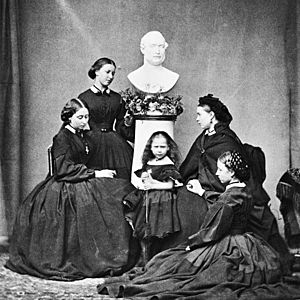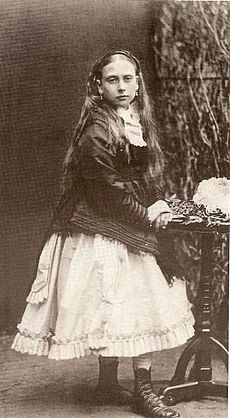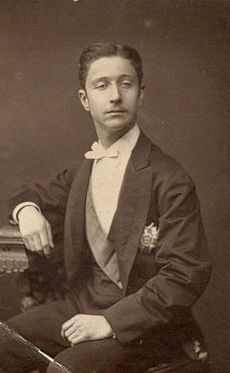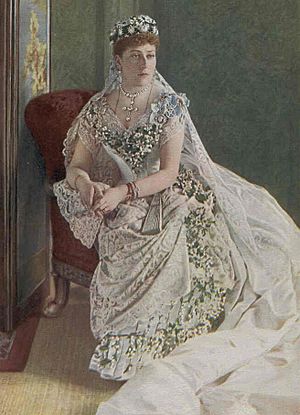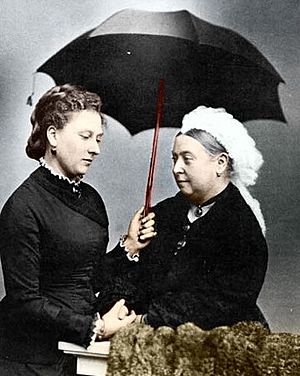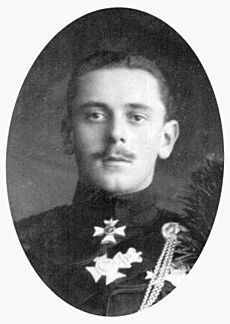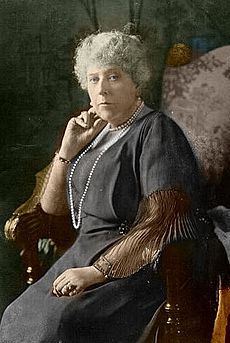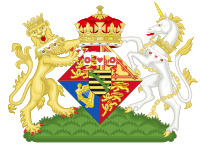Princess Beatrice of the United Kingdom facts for kids
Quick facts for kids Beatrice |
|||||
|---|---|---|---|---|---|
| Princess Henry of Battenberg | |||||
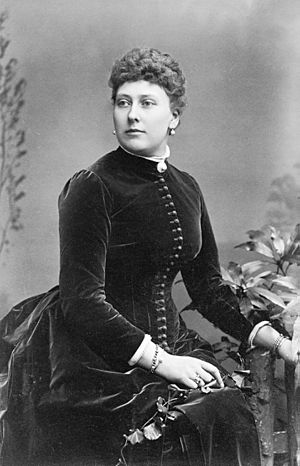
Princess Beatrice in 1886
|
|||||
| Born | 14 April 1857 Buckingham Palace, London, England |
||||
| Died | 26 October 1944 (aged 87) Brantridge Park, Sussex, England |
||||
| Burial | 3 November 1944 St George's Chapel, Windsor 27 August 1945 St. Mildred's Church, Whippingham |
||||
| Spouse |
Prince Henry of Battenberg
(m. 1885; died 1896) |
||||
| Issue |
|
||||
|
|||||
| House | Saxe-Coburg and Gotha (until 1917) Windsor (from 1917) |
||||
| Father | Prince Albert of Saxe-Coburg and Gotha | ||||
| Mother | Queen Victoria of the United Kingdom | ||||
Princess Beatrice (Beatrice Mary Victoria Feodore; born April 14, 1857 – died October 26, 1944) was a British princess. She was the youngest child of Queen Victoria and Prince Albert. Beatrice was also the last of Queen Victoria's children to pass away. She lived almost 66 years longer than her oldest sister, Alice.
Beatrice grew up during a sad time for Queen Victoria. Her father, Prince Albert, died in 1861. As her older sisters got married and moved away, the Queen relied more and more on Beatrice. Queen Victoria called her "Baby" for many years.
The Queen wanted Beatrice to stay with her always. She didn't want her youngest daughter to marry. But many people thought Beatrice would make a good wife. One of them was Louis Napoléon, Prince Imperial, the son of the French Emperor. Beatrice liked him, but he died in a war in 1879.
Later, Beatrice fell in love with Prince Henry of Battenberg. He was the brother-in-law of her niece. After a year, Queen Victoria finally agreed to the marriage. But she had one rule: Beatrice and Henry had to live with her. They were married on July 23, 1885.
Beatrice and Henry had four children. But after 10 years of marriage, Prince Henry died in 1896. He got malaria while fighting in a war. Beatrice stayed by her mother's side until Queen Victoria died in 1901. For the next 30 years, Beatrice worked on editing Queen Victoria's diaries. She also kept making public appearances. Princess Beatrice died in 1944 when she was 87 years old.
Contents
Princess Beatrice's Early Life
Princess Beatrice was born on April 14, 1857, at Buckingham Palace in London. She was the ninth and youngest child of Queen Victoria. Her father was Prince Albert. Her birth was special because Queen Victoria used chloroform to help with the pain. This was a new and debated idea at the time.
Queen Victoria was very happy with her new baby. She wrote in her journal, "It's a fine child, and a girl!" Beatrice was given the names Beatrice Mary Victoria Feodore. She was baptized on June 16, 1857.
From the start, Beatrice was a favorite child. Her older sister, the Princess Royal, was moving to Germany. So, Beatrice got a lot of attention. Prince Albert thought Beatrice was very promising. He said she had a "good voice!"
Queen Victoria usually didn't like babies much. But she liked Beatrice and thought she was pretty. She called Beatrice "a pretty, plump and flourishing child." Beatrice had "fine large blue eyes" and "very fine skin." The Queen loved to give Beatrice her bath. Beatrice was also very smart, which pleased her father.
Prince Albert called Beatrice "the most amusing baby we have had." She had a more relaxed childhood than her siblings. This was because she was the youngest and last child. Her cheerful ways brought comfort to her father.
A Queen's Closest Companion
In March 1861, Queen Victoria's mother passed away. The Queen was very sad. Beatrice tried to comfort her. She told her mother that her grandmother was "in heaven." This helped the Queen, who had become distant from her other children. Only her eldest unmarried daughter, Princess Alice, and Beatrice were close to her.
Queen Victoria relied on Beatrice and Alice even more after Prince Albert died. He passed away from typhoid fever in December 1861. The Queen was heartbroken. She often took Beatrice from her crib and held her close.
After 1871, all of Beatrice's older sisters were married. Queen Victoria then depended fully on her youngest daughter. Beatrice had said early on, "I shall never be married. I shall stay with my mother." She became her mother's unofficial secretary. She wrote letters for the Queen. She also helped with important political papers.
Beatrice also took on more personal tasks. When the Queen was sick in 1871, Beatrice wrote down her journal entries. In 1876, she helped sort music that the Queen and Prince Albert used to play. This music had been untouched since his death.
The Queen's letters show how much she appreciated Beatrice. Her need for Beatrice grew stronger over time. In 1883, the Queen's trusted servant, John Brown, died. The Queen was sad again. She relied on Beatrice for support. Unlike her siblings, Beatrice had always liked John Brown. They often worked together to help the Queen.
Finding Love and Marriage
Who Could She Marry?
Queen Victoria did not want Beatrice to marry. She expected Beatrice to stay with her forever. But several men were suggested as possible husbands for Beatrice. One was Napoléon Eugéne, the French Prince Imperial. He was the son of the exiled Emperor Napoleon III of France.
After France lost a war in 1870, Napoleon's family moved to England. Queen Victoria became good friends with the Prince Imperial's mother. Newspapers even said Beatrice and the Prince Imperial would marry. But these rumors ended when he died in a war in 1879. Queen Victoria's journal shows how sad they all were.
After his death, Beatrice's brother, the Prince of Wales, had another idea. He suggested Beatrice marry their sister Alice's husband, Louis IV, Grand Duke of Hesse. Alice had died in 1878. The Prince thought Beatrice could be a mother to Louis's children. She could also stay in England to care for the Queen.
However, the law at the time said Beatrice could not marry her sister's widower. The Prince of Wales tried to change this law. But the idea was rejected by the House of Lords. The Queen was disappointed but also happy to keep Beatrice by her side.
Other men were also suggested, including two of Prince Henry's brothers. But none of them worked out. While attending a wedding in Germany, Beatrice met and fell in love with Prince Henry of Battenberg. He felt the same way about her.
Her Engagement and Wedding Day
When Beatrice told her mother she wanted to marry Henry, the Queen was silent. For seven months, the Queen did not speak to Beatrice directly. She only communicated through notes. This behavior surprised everyone. The Queen was afraid of losing her daughter.
Beatrice's sisters helped convince the Queen. They reminded her how much happiness Beatrice brought to Prince Albert. Finally, the Queen agreed to the marriage. But she had a strict condition: Henry had to give up his German duties. He and Beatrice had to live permanently with the Queen.
Beatrice and Henry were married on July 23, 1885. The wedding took place at St Mildred's Church, Whippingham on the Isle of Wight. Beatrice wore her mother's wedding veil. Queen Victoria and Beatrice's oldest brother walked her down the aisle. Ten of Beatrice's nieces were her bridesmaids.
The couple went on their honeymoon nearby. The Queen was sad to see them go. She later admitted she "fairly gave way" to tears after they left.
Life with Queen Victoria
After a short honeymoon, Beatrice and Henry returned to the Queen. They kept their promise to live with her. The Queen made it clear she needed them close. She did not want them to travel without her. Although she later eased this rule, they mostly made short visits to Henry's family.
Beatrice's love for Henry grew stronger, like the Queen's love for Prince Albert. When Henry traveled alone, Beatrice was much happier when he came back. Henry's presence made the court brighter. It had been sad since Prince Albert's death.
Henry wanted to join military campaigns. This upset the Queen, who worried about his safety. Conflicts also arose when Henry went to parties and kept "low company." Beatrice even sent a naval officer to bring him back once. Henry felt trapped by the Queen's constant need for him and Beatrice.
Despite being married, Beatrice continued to be the Queen's full-time helper. She was her mother's trusted friend and secretary. Queen Victoria grew fond of Henry. However, the Queen criticized Beatrice during her first pregnancy. She thought Beatrice should keep coming to dinner, even when she felt unwell.
Beatrice gave birth to four children. Alexander was born in 1886. Victoria Eugenie (Ena) in 1887. Leopold in 1889. And Maurice in 1891. Beatrice also became interested in social issues, like conditions in coal mines.
Henry became bored with court life. He wanted more to do. So, the Queen made him Governor of the Isle of Wight in 1889. But he still wanted military adventure. He asked the Queen to let him join a war in Africa. Despite her worries, the Queen agreed. Henry and Beatrice said goodbye on December 6, 1895. They never saw each other again.
Henry got malaria and was sent home. On January 22, 1896, Beatrice received a telegram. It told her that Henry had died two days earlier.
Beatrice was heartbroken. She left court for a month to mourn. Then she returned to her mother's side. The Queen wrote that Beatrice was "piteous in her misery." Even with her grief, Beatrice remained loyal to her mother. As Queen Victoria got older, she relied on Beatrice even more.
The Queen gave Beatrice apartments at Kensington Palace. She also made Beatrice the Governor of the Isle of Wight, a role Henry had held. The Queen even had a darkroom installed at Osborne House for Beatrice's photography hobby.
Later Years and Family Changes
Beatrice's life changed completely when Queen Victoria died on January 22, 1901. Beatrice wrote that she could "hardly realise what life will be like without her." Beatrice continued to appear in public. But her role at court was smaller. She was not as close to her brother, now Edward VII.
After inheriting Osborne House, the King removed and destroyed some of his mother's personal items. This included things related to John Brown, whom he disliked. Queen Victoria had wanted Osborne to be a private home for her family. But the new King did not need it. He planned to turn part of it into a hospital and open other parts to the public.
Beatrice and her sister Louise strongly disagreed. Their mother had given them homes on the estate. Their privacy was now at risk. Beatrice argued that the house should stay in the family. But the King gave the main house to the nation. The private apartments were kept as a memorial to the Queen.
Princess Beatrice was the Governor of the Isle of Wight from 1896 until her death in 1944. She was also the President of a hospital in East Cowes.
Stepping Back from Public Life
Beatrice kept making public appearances after her mother's death. These events often related to Queen Victoria. The public always connected Beatrice with the late Queen.
Beatrice's daughter, Ena, was known for her beauty. She was a desirable bride. She chose to marry Alfonso XIII of Spain. This marriage caused some problems in Britain. Ena had to become Catholic. Beatrice's brother, King Edward VII, was against this.
The couple married on May 31, 1906. An anarchist tried to bomb them on their wedding day. Ena became unpopular in Spain. Her son, the heir to the throne, had haemophilia. Alfonso blamed Beatrice for bringing the disease to the Spanish royal family. He turned against Ena.
Ena often visited her mother in Britain. But she usually came without Alfonso or her children. Beatrice lived at Osborne Cottage until 1913. Then she moved to Carisbrooke Castle. She also kept an apartment at Kensington Palace. She helped collect items for the Carisbrooke Castle museum, which she opened in 1898.
Beatrice appeared less in public as she got older. She was very sad when her favorite son, Maurice, died in World War I in 1914. After this, she started to retire from public life.
During the war, King George V changed the royal family's name. It went from Saxe-Coburg and Gotha to Windsor. This was to sound less German. Beatrice and her family also gave up their German titles. Beatrice stopped using the title Princess Henry of Battenberg. She went back to being HRH The Princess Beatrice. Her sons also changed their names. Alexander became Sir Alexander Mountbatten. He later became the Marquess of Carisbrooke. Leopold became Lord Leopold Mountbatten. He had haemophilia and died during a knee operation in 1922. He was almost 33 years old.
After the war, Beatrice supported a group called The Ypres League. This group was for war veterans and families who lost loved ones. Beatrice herself had lost her son Maurice in the war. She made rare public appearances for memorials. She laid wreaths at the Cenotaph in 1930 and 1935.
Her Final Years
Even in her seventies, Beatrice kept in touch with friends and family. She made rare public appearances. For example, she viewed wreaths after King George V died in 1936. She published her last book in 1941. It was a translation of her grandmother's diary.
Beatrice spent her final years at Brantridge Park in West Sussex. This home belonged to her niece, Princess Alice, and her husband. Beatrice died peacefully in her sleep on October 26, 1944. She was 87 years old. Her funeral was held at St George's Chapel, Windsor Castle. Her coffin was placed in the royal vault. Later, on August 27, 1945, her body was moved. She was buried next to her husband at St Mildred's Church, Whippingham. This fulfilled her wish to be buried with him on the island she loved.
Princess Beatrice's Legacy
Beatrice was the shyest of Queen Victoria's children. But because she was always with the Queen, she became well-known. Despite her shyness, she was a good actress and dancer. She was also a talented artist and photographer. She loved her children very much.
To her friends, she was loyal and had a good sense of humor. As a public figure, she felt a strong sense of duty. She supported the Royal National Lifeboat Institution on the Isle of Wight. Music was a passion for Beatrice, just like for her parents. She played the piano very well and sometimes composed music. Like her mother, she was a very religious person. Princess Beatrice was known for her calm nature and kindness.
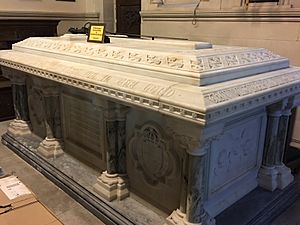
Beatrice had many duties during her mother's reign. She suffered from rheumatism, but she still had to endure her mother's love for cold weather. Her piano playing became harder because of her illness. But she still did everything for her mother. The British public noticed her efforts.
In 1886, she opened a flower show. The organizers thanked her. They admired "the affectionate manner in which you have comforted and assisted your widowed mother." As a wedding gift, a banker gave Beatrice and Henry a silver tea set. It said, "Many daughters have acted virtuously, but thou excellest them all." The Times newspaper also praised her devotion to the Queen.
She died at Brantridge Park, her niece's home. Osborne House, her mother's favorite home, is now open to the public. Beatrice's former homes at Osborne, Osborne and Albert Cottages, are still privately owned.
Titles and Awards
Her Royal Titles
- April 14, 1857 – July 23, 1885: Her Royal Highness The Princess Beatrice
- July 23, 1885 – July 14, 1917: Her Royal Highness The Princess Beatrice, Princess Henry of Battenberg
- July 17, 1917 – October 26, 1944: Her Royal Highness The Princess Beatrice
Special Awards
- British awards
- January 1, 1878: Order of the Crown of India
- January 8, 1919: Dame Grand Cross of the British Empire
- June 12, 1926: Dame Grand Cross of St John
- May 11, 1937: Dame Grand Cross of the Royal Victorian Order
- Royal Order of Victoria and Albert
- Royal Red Cross
- Foreign awards
 Grand Cross of St. Catherine
Grand Cross of St. Catherine September 11, 1875: Dame of the Order of Queen Saint Isabel
September 11, 1875: Dame of the Order of Queen Saint Isabel April 25, 1885: Dame of the Golden Lion
April 25, 1885: Dame of the Golden Lion May 27, 1889: Dame of the Order of Queen Maria Luisa
May 27, 1889: Dame of the Order of Queen Maria Luisa
Her Coat of Arms
In 1858, Beatrice and her three younger sisters were allowed to use the royal coat of arms. It had a small shield of Saxony in the middle. It also had a special white label with three points. On Beatrice's arms, the outer points had red roses. The center point had a red heart. In 1917, the Saxony shield was removed.
| Princess Beatrice's coat of arms (1858–1917) |
Her Children
| Portrait | Name | Birth | Death | Notes |
|---|---|---|---|---|
 |
Prince Alexander of Battenberg later Alexander Mountbatten, 1st Marquess of Carisbrooke |
November 23, 1886 | February 23, 1960 | Married Lady Irene Denison on July 19, 1917. They had 1 daughter (Lady Iris Mountbatten). |
 |
Princess Victoria Eugénie of Battenberg later Queen of Spain |
October 24, 1887 | April 15, 1969 | Married Alfonso XIII of Spain on May 31, 1906. They had 2 daughters and 5 sons (1 was stillborn). |
 |
Prince Leopold of Battenberg later Lord Leopold Mountbatten |
May 21, 1889 | April 23, 1922 | He had haemophilia. He died during a knee operation. He was not married and had no children. |
 |
Prince Maurice of Battenberg | October 3, 1891 | October 27, 1914 | He died from injuries during World War I. |
See also
 In Spanish: Beatriz del Reino Unido para niños
In Spanish: Beatriz del Reino Unido para niños



